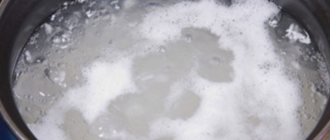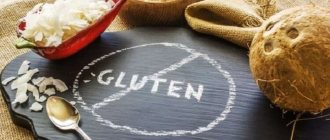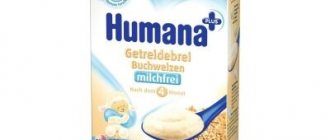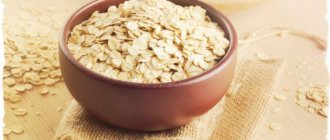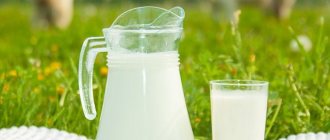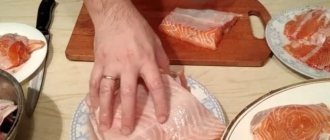As soon as the baby stops actively sucking the breast and gradually switches to adult food, mommy can’t wait to please him with new products. Complementary feeding should be introduced based on the doctor’s recommendations. Food should be healthy, fresh, ground, nutritious and appropriate for the child’s age. Oatmeal for babies is an ideal option for baby food. In terms of usefulness, it is second only to buckwheat. From what month can you give oatmeal to babies and are there any contraindications?
What are the benefits of oatmeal for an infant?
People have known about the benefits of oatmeal for a long time. Oats improve mental abilities, improve digestion, and fill the body with vitamins. Oatmeal is especially useful for infants, as its composition is similar to breast milk, and many children love to eat it.
- The B vitamins it contains have a positive effect on the nervous system, providing a calming effect. Children with nervous pathologies are recommended to use it regularly;
- microelements, vitamins and organic acids contained in oats normalize cholesterol in the blood;
- oatmeal is quickly absorbed, saturating the body;
- enveloping the gastric mucosa, promotes digestion and cleansing of the intestines;
- relieves constipation;
- potassium and magnesium improve heart function;
- oats remove toxins, salts, heavy metals, cleanse the blood;
- thanks to phosphorus, the functioning of the musculoskeletal and muscular systems improves;
- a large amount of iron restores hemoglobin levels and relieves anemia;
- iodine improves metabolism.
Oatmeal for babies is a valuable product that promotes normal development and improved health.
Helpful: Normal development of a baby is impossible without protein - read the article on how to properly feed meat to a baby
Oatmeal and baby
I think everyone knows that simple rolled oats are not suitable for a baby. Children's first porridge is cooked from flour, which is made from cereals. This appearance misleads many mothers into thinking that in this form it will be absorbed better, because it is so airy and small.
But in fact, the gluten protein, which is part of the cereal, does not disappear anywhere after grinding. It can cause bloating and cause very unpleasant sensations for the baby. If your little one’s digestive system has not yet been adjusted, then feeding oatmeal with oatmeal should be postponed.
Can it harm
Despite the usefulness of oatmeal, doctors do not recommend introducing it into complementary foods first. Oats contain gluten, which causes serious allergies in children. This protein is poorly digested by infants , since there are not yet enough enzymes in the children's intestines that can break down the complex composition of oats.
- Another disadvantage of oatmeal is the removal of calcium from the body. Phytic acid in the composition does not allow calcium to be absorbed, which negatively affects infants, who need this element vitally.
- Oatmeal contains starch, a source of calories. It breaks down in the body into sugar, which increases glucose levels. Excessive consumption of oatmeal threatens the development of diabetes. Infants are allowed to give oatmeal no more than once a week.
Choice
Porridge is introduced into the diet from 4-6 months. Choose gluten-free cereals. Liquid porridge cooked in water before bed helps to fully saturate the body.
At the initial stage of artificial feeding, pediatricians recommend that infants cook on their own. The first to try is rice and buckwheat.
Porridges in packs are introduced later, when the child is accustomed to single-component types. From 9 months, parents can purchase packaged milk formulas. The first portions should be no more than 7 grams. This is how a child’s reaction to cow’s milk is tested.
If there is no lactose intolerance, the portions are increased. The average amount of milk porridge is 150-200 grams. Their parents cook their own.
It is acceptable to use baby cereals at night during the first feeding. This way you can control the portion size. Manufacturers provide for the selection and grinding of raw materials suitable for a specific age.
Early use of formulas containing goat's milk is not recommended. It is difficult for a six-month-old baby to digest it.
From 1-1.5 years you can give ready-made drinking products. Specialized drinks containing prebiotics normalize sleep, helping to form a rest regime. For dinner they prepare barley, semolina, corn and oatmeal porridge. The baby's porridge is cooked without mixture at night.
When to introduce into complementary foods
An enzyme that helps digest gluten is produced in children's intestines from 8-10 months. Gluten acts like a poison and causes allergies. Doctors recommend introducing oats into complementary foods from the age of 9 months for breastfed children, and after 8 months for formula-fed children after the baby has mastered gluten-free rice, corn and buckwheat.
The main rule for introducing a new product is a small dose in the morning. Then observe the reaction. If the baby does not have negative symptoms, the portion can be increased little by little. At the first symptoms of an allergy, postpone taking oatmeal for several weeks, then try again. Complementary feeding should not be introduced if the baby is sick, recovering from an illness, or has been vaccinated. He will react negatively to any change in diet. You need to wait 2-3 weeks until the immune system is stronger and the body is ready for food experiments.
It is advisable for mom to keep a food diary for her baby. When introducing a new product, she records the date, product name, and reaction. If the reaction is normal, continue to use the product. If there is an allergy, it is underlined in red and the expected date of the second attempt at introduction into the diet is recorded.
Interesting: here we talked about the benefits of corn porridge for babies -
Is it possible to harm a child’s body by feeding him oatmeal?
Despite the benefits of oatmeal, pediatricians do not recommend starting your baby’s introduction to porridge with it. There are several explanations for this:
- high calorie content;
- the phytic acid contained in the composition washes out calcium (because of this, you should not eat oatmeal every day);
- a large amount of starch, which, when ingested, turns into sugar and increases glucose levels. Constant consumption of porridge can cause the development of diabetes.
Oatmeal is high in calories
Some children, after introducing oatmeal into their diet, experience indigestion, bloating, pain in the intestines, nausea and vomiting. These may be symptoms of fiber intolerance. In this case, you should temporarily postpone its introduction into complementary foods and consult your pediatrician.
Doctors do not recommend giving oatmeal to children with diarrhea, so as not to provoke a worsening of the situation.
Possible reaction to gluten
Gluten is a plant protein found in some grains, including oats. To break it down, a special enzyme must be present in the body - aminopeptidase, which begins to be produced in the gastrointestinal tract only from 8-10 months. Until this time, gluten is a toxin that causes food allergies in many babies.
How to choose oatmeal
The taste and quality of the cooked porridge depends on the type of oatmeal. There are several ways to process grains, differing in name, composition, method and duration of preparation.
- Uncrushed groats are whole oat grains, peeled from the shell. The most useful, containing all the valuable elements necessary for the normal growth and development of a child. They take a very long time to cook (at least 2 hours), which is inconvenient for mothers of infants. Therefore, this type of oatmeal is often included in the diet of older children.
- Polished cereals are grains that have been mechanically processed and have lost some of their valuable fiber. You can cook this grain in 40 minutes.
- Hercules flakes. Of all the types, they flatten less, maintaining their shape, and lose less nutrients. Used in dietary and baby food. Prepare in no longer than 20 minutes.
- Cereals Extra. Prepare in 15 minutes. During production they are crushed and contain the most starch and gluten. Flakes are divided into 3 grades, depending on how they are crushed. If the number “3” is on the package, it can be given to a baby. This is the finest grind and after cooking the porridge will be tender and airy.
- Oatmeal. Steamed, peeled barley and oat grains are ground into flour. Oatmeal is useful for anemia and stomach diseases. Pour boiling water over it and after 2-3 minutes it’s ready to eat.
- Flour is grains crushed into powder. Used to make oatmeal cookies and flatbreads.
To prepare oatmeal, it is better to buy Hercules flakes. They are quick to prepare and include all the necessary ingredients. Before cooking, the flakes must be ground in a blender or coffee grinder. You can grind the entire pack in advance so as not to waste time when you later need to quickly feed your baby.
Store oatmeal and cereal in the refrigerator. This way the beneficial properties will last longer. High-quality oatmeal should not be pale gray, but creamy in color and have a light natural aroma. If the cereal is purchased in a cardboard box, it is better to pour it into a plastic bag so that it does not pick up moisture and spoil.
Cook it yourself or buy ready-made porridge?
Today there is an urgent issue about harmful additives that can be found in various products. Cereals are no exception. That is why parents often find themselves faced with a choice: buy special baby food for their baby or prepare meals themselves. Doctors cannot come to a consensus and say that one or another option is definitely correct. Therefore, each mother decides for herself how to organize the baby’s nutrition.
On store shelves you can see a huge number of cereals from different manufacturers, which are intended for children in their first year of life. They have their advantages:
- composition (industrially produced baby food is enriched with vitamins and minerals that are necessary for the baby’s body, as well as probiotics and prebiotics that help normalize the functioning of the gastrointestinal tract);
- ease of preparation (does not require cooking, just dilute with water or milk);
- liquid consistency (just what babies who cannot chew need);
- quality control.
Photo gallery: oatmeal for first feeding from different baby food manufacturers
Pediatricians recommend starting complementary feeding with dairy-free cereals, which is exactly what Nestle oatmeal is.
Hipp oatmeal contains no sugar.
Malyutka oatmeal is enriched with iron
Bebi Premium porridge is made with goat's milk, which is easier to digest than cow's milk.
Fruto Nanny porridge improves baby's digestion
Clear Sun porridge consists of finely ground flakes
Despite the huge selection of baby food, many parents prefer to prepare porridge for babies themselves. The child’s digestive system cannot yet accept food in pieces, so the oatmeal must be chopped before or after cooking. Porridge made independently also has certain advantages:
- parents can be sure that the dish does not contain any impurities or harmful substances;
- Whole grains contain more vitamins and minerals than processed baby foods;
- You can choose different types of oatmeal or flakes.
There are porridges with added fruit and oat flakes of different sizes on sale: large, medium and small. Small ones (for example, “Clear Sun”) are more suitable for feeding a baby.
Table: types of oatmeal
| Type of oatmeal | Treatment | Characteristic | Calorie content in uncooked form per 100 g | Is it suitable for breastfeeding? |
| Uncrushed | oat grains from which the hull has been removed | contains a lot of gluten and little starch | 303 kcal | This type of cereal contains the most nutrients and vitamins, however, it needs to be cooked for about two hours, which is not very convenient. More often used for preparing dishes for older children. |
| Flattened | grains that have undergone mechanical processing twice | high in vitamins and minerals, but less fiber compared to whole oats | 340 kcal | Cooking takes 40 minutes, and the vitamin content does not decrease during heat treatment. Suitable for babies. |
| Cereals "Hercules" | thick flakes of refined grains | contains a lot of fiber, suitable for children who have digestive problems | 352 kcal | They do not contain as many useful substances as cereals, but they are prepared in no more than 20 minutes. Can be given to infants. |
| Cereals "Extra" | prepared from whole and crushed cereals | there are three types:
| 386 kcal | Only small flakes are suitable for babies. After 15 minutes of cooking, the oatmeal will be ready, and the dish will turn out tender and airy. Suitable for babies. |
| Oatmeal | flour from grains that have previously been steamed, dried, fried, cleaned and ground | retains a large amount of B vitamins, amino acids, iron | 369 kcal | Oatmeal cooks quickly: you need to pour boiling water over it and wait 2-3 minutes. Useful for children who suffer from gastrointestinal diseases. |
How to cook oatmeal for babies
Oatmeal is ground into powder. The optimal proportion for feeding a baby is considered to be five percent porridge. Place 5 g of the resulting powder in a teaspoon. It is diluted with 100 ml. water. If the volume is needed large, the proportion is doubled. When the child grows up, you can increase the oat intake to 10 g per 100 ml. water.
How to cook it yourself
Classic porridge
Pour oatmeal into boiling water and, stirring, cook for 5 minutes. Infants are very conservative and do not like changes in diet. To help the baby get used to the unfamiliar taste, breast milk is added to the porridge. Salt, sugar, milk and butter are added when the child’s stomach gets stronger and gets used to the new food.
Interesting : why is beets so beneficial for babies and how to start giving them correctly?
Porridge with milk
When the baby gets used to oatmeal and is allowed to drink cow's milk, you can prepare oatmeal with whole milk. To do this, the flakes do not need to be ground and can be used in the form in which they are purchased. They are sorted, washed, and blotted with a towel. For a glass of water, take the same amount of low-fat milk and 2 tbsp. oatmeal. Boil water, add sugar and a little salt. Milk porridges add much less salt than porridges cooked with water. Salt is added to milk porridge before the cereal. Add oats, stirring constantly. Cook the porridge over low heat until fully cooked. Boil milk in a separate bowl and pour it into the mixture through a sieve. Add a little butter to the finished oatmeal.
Oatmeal porridge
In 100 ml. boiled water diluted with 3 tbsp. oatmeal Boil water (if the child cannot tolerate cow protein) or milk, add oatmeal and cook for 2-3 minutes, stirring constantly. For a one-year-old child, you can put a piece of fruit or berry in the porridge - banana, apple, strawberry.
Important! Mom should definitely try the finished porridge herself. Oatmeal sometimes turns out bitter. Most often this happens due to a low-quality product that was stored incorrectly or due to unsuitable water. Finely ground flakes are usually not bitter.
Recipe for cooking in a slow cooker
You can cook oatmeal with milk for your child in a slow cooker:
- 200 ml. water and 50 ml. low fat milk is poured into a bowl.
- Add 3 tbsp. spoons of oatmeal. You can use coarse grains without chopping. Before cooking, it needs to be sorted and washed.
- Add a teaspoon of sugar and 1/3 tsp. salt.
- Depending on the type of multicooker, set the cooking time. Press the “Milk porridge” button and close the valve.
- Mix the finished oatmeal, pour it into a plate and add butter to taste.
Will be on topic : legumes are good for adults and children, so mothers are wondering at what age it is allowed to give pea soup to children
Experience of introducing oatmeal into infant feeding: reviews from mothers
I Nordic bought oat flakes, it cooks for 3 minutes, there are large ones, there are small ones, very tasty.
Tanita
https://www.u-mama.ru/forum/kids/child-health/66902/index.html
Yeah, I also cook Nordic. I really like it, and I ground regular Hercules flakes in a coffee grinder, it’s almost the same thing, but it takes longer to cook.
Tanchez
https://www.u-mama.ru/forum/kids/child-health/66902/index.html
I boil regular cereal for 20-30 minutes and then blend it. And this is what I have been feeding my baby in the morning since he was 8 months old. On water, without salt and sugar.
Tanya's joy
https://www.u-mama.ru/forum/kids/child-health/66902/index.html
We introduced dairy-free milk at 9 months. At first they tried at 6, but the allergies broke out, apparently the gastrointestinal tract was not ready. Now we're eating normally.
Alexandra
https://www.babyblog.ru/community/post/baby_food/3037533
But I like it without additives, I also cook mine without salt and sugar, but with milk))) We also introduced it after corn, my son eats well without anything, but sometimes I add a banana and a little butter.
Nadia
https://www.babyblog.ru/community/post/baby_food/3037533/1#comm_start
Benefits and harms
Oatmeal is a real storehouse of vitamins, microelements, vegetable proteins, dietary fiber and complex carbohydrates.
Useful properties of oatmeal:
- Promotes quick saturation;
- Improves the condition of hair and skin;
- Positively affects the functioning of the nervous system;
- Normalizes cholesterol levels in the body;
- Eliminates problems in the intestines;
- Indispensable for the diet of a child under one year old;
Sometimes this product can harm the body:
- Cereals contain gluten, which can cause allergic reactions;
- You should not eat oatmeal if you have celiac disease;
- Frequent consumption of oatmeal is prohibited; calcium will no longer be absorbed in the body;
- Porridge is very high in calories and leads to obesity.
More on the topic “Porridge for first complementary feeding: dairy or dairy-free, which porridge to start complementary feeding with”:
Praise porridge to start complementary feeding
They told me to introduce porridge, we’ve been trying to eat vegetables for a month now without much success, mostly on guard duty until now, the pediatrician said to try porridge, which brand is better?
How to make dairy-free porridge with formula or breast milk?
I ask for advice, dear mothers. I’m trying to continue breastfeeding (we are a little allergic, and the doctor advises), although of course sometimes I had to supplement, because of my nerves there was little milk. But then we started complementary feeding, we started eating dairy-free porridge, but we don’t eat it at all on the water. I don’t want to go on formula yet, and it’s expensive, for supplementary feeding it’s painful for the budget. While we have been told to eat dairy-free cereals, we don’t eat them, so is it possible to give dairy-free cereals with breast milk? Or is it impossible?
Porridge for first feeding
What kind of porridge is better, I mean wheat, rice, oatmeal or something else, to use for the first feeding? It’s just that I’ve been reading all sorts of things here and I’m completely confused, oatmeal is where it’s allowed and where it’s not, buckwheat can’t be found in children’s porridges at all now.
Milk porridges - which are the best?
Tell me, which dairy porridges are considered the most normal without any extra additives? We ate non-dairy baby sitter and remedia, but I haven’t studied the market with dairy ones yet...
milk and dairy-free porridge
What is dairy-free porridge for? I only have enough milk to eat, and I don’t want to express anymore. on the box it says to dilute it with breast milk, mixture or vegetable broth. but we don’t eat the mixture; the vegetable broth probably won’t be satisfying. can I buy dairy? please enlighten me.
stool after 1st feeding
Experienced mothers, please tell me, if after the first introduction of buckwheat porridge (generally the first time in life, half a spoon), a child (on breastfeeding) immediately (after 10 minutes) pooped something slimy (the color is close to normal stool) - this indicates intestinal rejection of this food? We started at 5 months with cereal because he wasn’t gaining enough...
Instant cereal for 3.5 years?
We are almost 3.5 years old, but we can’t give up instant cereals. That is, he eats normal food in the garden all day, and at home on weekends. In the morning I always cook porridge for him - buckwheat, semolina, oatmeal, etc. But before going to bed, he always asks for instant porridge from a box (such as for 6-month-olds) or instant porridge “Doctor Benner”.
First porridge
We plan to introduce porridge closer to 6 months. Is the first dairy or dairy-free? Rice or buckwheat? Without additives or can we use those fruit lobs that we eat?
Porridge! And once again porridge!
I introduced dairy-free buckwheat porridge a week ago. And then which one to enter. Milk buckwheat or other dairy-free porridges? And how many grams of porridge does an almost 7-month-old baby need to eat?
Dairy-free porridge
How can you dilute these dairy-free porridges? Expressed milk is a thing of the past (for me). A milk substitute is understandable. Are there any other options?
To German mothers about porridge.
I’m thinking about introducing porridge in a month, I started looking at what’s available in nature. I didn’t like all these hippies - there’s semolina all around and there’s a lot of everything mixed in, there’s already glucosen sirup
